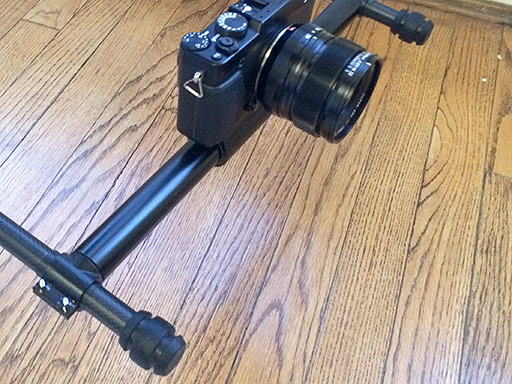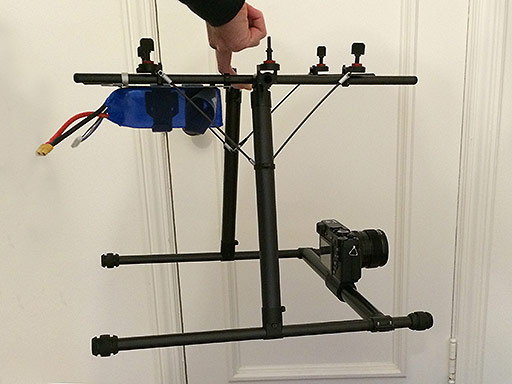i plan to use my S800 for aerial stills which will be used (among other things) in architectural visualizations. there is typically heavy editing involved and the opportunity to use very fast shutter speeds so i'm not too worried about vibration and i'm not at all worried about having servo/gimbal control from a fpv setup. this is new to me so i'm keeping it simple - a camera mounted on the copter taking a picture every second for the duration of the flight. next i'll wire a remote trigger to channel 7 or 8 of the receiver using one of those little turnigy switches, but not yet.
eventually i'll be lifting a heavy camera and lens combo, but for now i'm starting with a smaller camera - 450-600 grams depending on the lens.
this is the mount i made:

it's a combination of tube stock and a couple 3d printed (fdm of abs nylon, very strong and resilient) fittings. there's a cork covered mounting plate for the camera with a captive 1/4-20 standard tripod mount screw that's accessed through holes in the fitting and tube. it can be slid forward and back on the legs to balance the copter and rotated around the camera's long axis if desired, but it's really designed to be used straight ahead. as shown here the camera has to be pretty far forward to balance the battery:

so...... is this a terrible idea? i know most video mounts are directly in the center of the platform and a gimbal setup to keep rotations around the axis of the camera. but if vibration isn't really an issue (i am assuming the thing won't vibrate/move enough to blur a shot with a wide angle lens at 1/2000s or so), why not keep it simple and away from the legs and props?
i haven't flown with this attached yet. any reason not to?
eventually i'll be lifting a heavy camera and lens combo, but for now i'm starting with a smaller camera - 450-600 grams depending on the lens.
this is the mount i made:

it's a combination of tube stock and a couple 3d printed (fdm of abs nylon, very strong and resilient) fittings. there's a cork covered mounting plate for the camera with a captive 1/4-20 standard tripod mount screw that's accessed through holes in the fitting and tube. it can be slid forward and back on the legs to balance the copter and rotated around the camera's long axis if desired, but it's really designed to be used straight ahead. as shown here the camera has to be pretty far forward to balance the battery:

so...... is this a terrible idea? i know most video mounts are directly in the center of the platform and a gimbal setup to keep rotations around the axis of the camera. but if vibration isn't really an issue (i am assuming the thing won't vibrate/move enough to blur a shot with a wide angle lens at 1/2000s or so), why not keep it simple and away from the legs and props?
i haven't flown with this attached yet. any reason not to?
